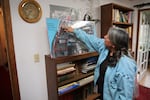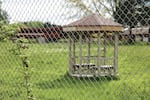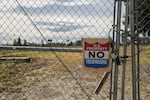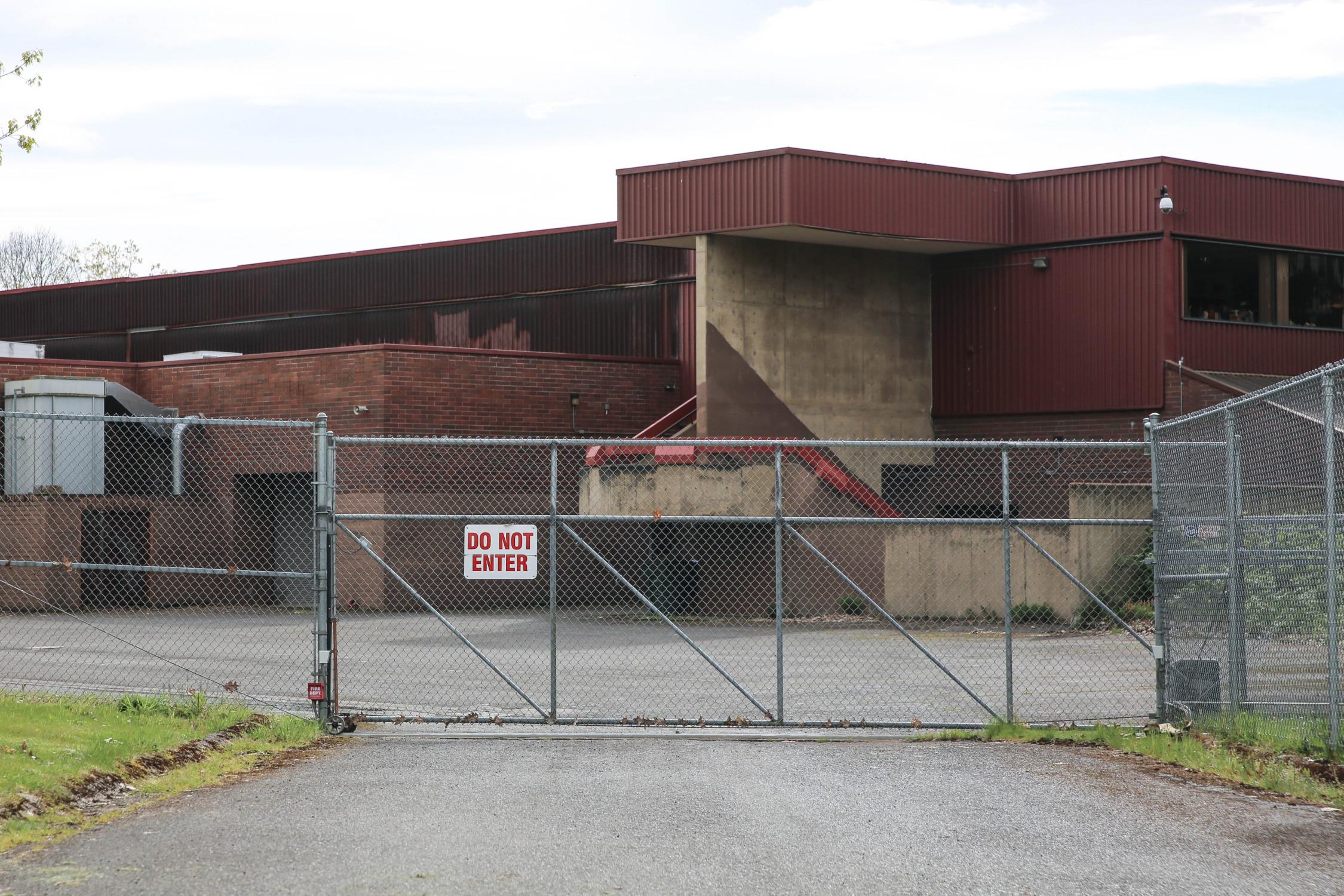Chemawa Indian School sits uphill of Interstate 5 at the north end of Salem, Oregon.
The campus isn’t easy to find and the federal government has made it even harder to visit.
Related: Chemawa Indian School
“Now, it has a huge wire fence around it,” said Delores Pigsley, the council chair of the Confederated Tribes of the Siletz Indians. “I don’t know if that’s to keep the kids in, or keep people out.”
Chemawa school leaders say the fence is needed for safety. But tribal leaders such as Pigsley, who lives just a few minutes away, say the barrier is symbolic as well. They say the school prioritizes locking students in on campus while walling off families and the public.
Just off the highway behind a wall of trees, chain-link fence and a thicket of federal bureaucracy, trouble at Chemawa has stayed hidden from outside scrutiny. Chemawa acts as a refuge for Native students from across the West. But the taxpayer-funded boarding school struggles to protect and educate students. Staff members who've complained over the years say administrators have ignored and retaliated against them.
For years, campus administrators also have struggled with other things: transparency and money.
Run By The Federal Government, Bought By Student Labor
In the basement of a house in rural Willamette Valley, SuAnn Reddick rustled through a trove of old photos, maps and documents of Chemawa.

SuAnn Reddick points to locations on a historic map of the Chemawa Indian School campus.
Rob Manning / OPB
Chemawa has a long, complicated history, and Reddick tracked it for years as the school’s volunteer historian.
She amassed so many boxes of documents, she has one full room dedicated to them in her home near McMinnville, Oregon.
Chemawa opened in 1880 in Forest Grove as part of the federal government’s efforts to forcibly assimilate Native American youth. The school moved five years later.
“The community was not particularly happy about having an Indian school over at Forest Grove, at Pacific University,” Reddick said. “And eventually, the school became sufficiently large to require more space.”
The school moved to Salem thanks in no small part to the labor of American Indian students. They earned money growing produce, making shoes and picking hops.
“They were not allowed to keep the funds because the money was used to help support the school,” Reddick said. “Students earned enough money to buy (one of) the first parcels of land, about 84 acres, upon which the historic campus was eventually built.”
Reddick said the documents aren’t entirely clear, but she said there’s evidence that Chemawa students may have funded the acquisition of the entire Salem campus.
Pigsley, the Siletz tribal chair, remembers how Chemawa grew to a few hundred acres. It became a thriving community with dozens of homes, a post office and acres of farmland. But it belonged to the U.S. government. The federal transportation department would eventually take a chunk of Chemawa’s land to build the interstate highway the school now sits beside.

Chemawa Indian School is located off Interstate 5, north of Salem.
Source: Google Earth
“I-5 went through the middle of the farm,” Pigsley said. “They lost all the farm property.”
The government tore down Chemawa’s old campus in the 1970s. Officials said the buildings had fallen into disrepair, though some dispute that.
“We came back and they were beginning to tear down all the old brick buildings,” Pigsley, who had been living in Kansas at the time, said.
Questions Surround Bureaucracy And Finances
Today, Chemawa’s physical campus looks very different than before. Low, modern buildings have replaced the original brick and the campus moved uphill, farther from the highway. But the governing structure is the same: Chemawa is part of the federal bureaucracy.
The school’s $10 million annual allocation is hard to find amid the vast federal budget. And when Congress reduces government spending — as it did during the Great Recession — Chemawa sees cuts too.
Chemawa receives most of its money from two sources: the U.S. Department of Interior and the U.S. Department of Education. President Trump’s proposed 2018 budget would slash funding for both agencies.
Marnie Grimmell lost her job as a school counselor in 2013 during an earlier round of cuts.
“That year we had a dean of students and two academic counselors,” Grimmell said. “And in the following year, that dean of students position went away. That person became the one academic counselor and the two academic counselors weren’t there.”
The superintendent at the time was fired over allegations of financial mismanagement, though staff offer differing opinions as to whether there was any way to appropriately handle Chemawa’s shrinking bottom line.
Former staff complain often of inadequate funding. But red tape is frustrating too.
Superintendent Lora Braucher explained the bureaucracy to an audience of future educators at Corban University last March. She took over the school in 2014 after a career in Florida’s public schools.
“My boss is in Phoenix. My human resources department is out of Albuquerque. My procurement and contracting and facilities is out of Portland,” Braucher said.
“So when you come [in] blind and very green from public ed, and you’re thrown into — I call it my island — because I don’t have anybody close by that is from my organization, you learn a lot quickly, but you also have a lot of challenges navigating.”
The murky bureaucracy also shrouds how Chemawa operates.
The campus that students helped buy more than a century ago still helps support the school financially through multiple business ventures.

Chemawa has a number of revenue-generating activities on campus.
MacGregor Campbell
The school rents out billboard signs on the east side of I-5. Chemawa owns a Christmas tree farm beneath them. The school also earns revenue by renting out athletic fields and the swimming pool.
Next to the big white water tank with “Chemawa” emblazoned on it, a cell phone company leases a transmission tower. Until a few years ago, there was a paintball course near the original campus site.
But years ago, contracts for those types of outside income were signed without proper oversight, according to officials at the Bureau of Indian Education, which oversees Chemawa and more than 180 other schools. And former Chemawa board members say the school hid information from them about those revenue streams.
Limited Power For Chemawa’s School Board
Bureau of Indian Education schools like Chemawa have school boards, though they’re different from the boards governing local public schools. Public school board members in Oregon often say they have two main jobs: to approve budgets and to hire and fire top officials such as the superintendent. Chemawa’s board of tribal members has final say on neither.
And while board members are easily identified at most school districts, you can find no such list for Chemawa. Federal rules indicate that board members come from tribes that regularly send a number of students to the school.
Tony Dearman, the director of the Bureau of Indian Education, said federal law forbids board members from hiring school superintendents, or any employees, that work at schools like Chemawa.
“They don’t have the authority — to hire and fire a federal employee, you have to be a federal employee [to do that],” Dearman said. “But they have to be involved in any of the processes.”
Dearman insisted board members have power when it comes to spending.
“They have to sign off on budgets, they have to concur with hires, they have to be part of the things that go on at the school,” Dearman said. Federal regulations confirm administrators at BIE schools are expected to consult with school boards.
If the school board of a public school district disagrees with its superintendent over the budget, board members can have the final say. But within BIE, such conflicts are ultimately settled by federal officials.
BIE can also be lax about ensuring schools actually have functioning boards. For at least a few years, Chemawa didn’t have one at all.
“There is one now. When I arrived here three years ago, there wasn’t one,” Braucher said in an interview with OPB. “It took me about a year, 18 months, to establish one.”
When there wasn’t a school board, hiring and budget decisions were approved within the BIE.
Former board members say they were told by administrators that they were simply “advisory.” That was confirmed in an email Braucher sent in December 2015 instructing her staff not to discuss day-to-day matters with board members.
“Be aware that our school board, according to Public Law 95-561, is an advisory board,” Braucher wrote.
BIE director Dearman chafed at that characterization in his interview with OPB.
“A lot of our school boards don’t like being called ‘advisory boards,’” Dearman said. “They’re policy, procedures.”
Board Members Question, Chemawa Administrators Shrug
Former members of Chemawa’s school board, like Coquille tribal member Cassie Ross, said their questions about operations and finances were routinely ignored by school administrators.

Cassie Ross is a former member of the Chemawa school board.
Rob Manning / OPB
“We were asking where was the money from the Christmas trees’ sale? Where was the paintball — how did that all fit into the big scheme?” Ross said. “And well, ask and ask and ask, and you don’t see it.”
“We’d question the billboard sign money,” said Freddie Lane, another former board member, who represented Washington’s Lummi tribe. “When we’d question the Christmas tree money and fields, these different leases, all this money was supposed to benefit the kids.”
Lane and Ross were asking about what school officials call the “student fund” account — a pool of money from on-campus enterprises intended to help students, largely for non-academic purposes. Administrators would try to reassure the board that the money helps offset student travel expenses or awards for special achievements, according to interviews with former board members and school officials.
Lane was never convinced, he said, because he was never shown the books.
“It gets tied up in bureaucracy. I always tell them, ‘I was born at night, I just wasn’t born last night,’” he said. “‘Show me the paper trail, show me how much is going to the kids’ fund.’ They always had an excuse.”
Former administrator Ted Mack served briefly as Chemawa’s acting superintendent in 2005 and again in 2011, and he served for years as the head of the residence halls. Mack said he was elevated into administration because he could decipher the school’s complicated budget documents.
“I found out how [the] budget worked, and basically that’s how I got into administration,” Mack said.
He said when he tried to share what he’d learned with school board members, he got in trouble.
“The superintendent at the time called me and said ‘Hey, you can’t tell people that,’” he said. “I was like, ‘Why not? They asked me.’”
After 20 years at the school, Mack said from his perspective, there isn’t “anything shady with the budget; some people just don’t understand how money is generated and where it goes.”
OPB also tried to understand the school’s finances, filing a Freedom of Information Act request for Chemawa’s budgets and financial information.
The Bureau of Indian Education took more than a year to respond. When the government finally provided records, they were heavily redacted. Some budget spreadsheets the agency released appeared to be copies of copies and were all but illegible.
After being told there were recent government audits of Chemawa, OPB filed a separate request for any investigations, inspections or audits from all four of the federal government’s off-reservation boarding schools. BIE responded with elevator and boiler room inspections from schools other than Chemawa. The bureau turned over no audits of Chemawa’s finances or educational programs, despite agency officials and school staff informing OPB that annual audits had been conducted.
In recent interviews, Dearman and Braucher insisted that BIE provided financial oversight of schools and supervised regular audits of Chemawa’s books. When OPB asked to see records of the audits, the BIE director backpedaled.
“They’re not actual audits,” Dearman said. “It’s oversight of all the expenditures … to make sure schools aren’t going to finish in the red, that there’s not money left that’s going to be pulled back… [we] don’t have an audit report.”
Braucher said that since the establishment of a school board in 2015, it has approved the annual campus budget. But she did not respond to OPB’s verbal and written requests for the board-approved budget documents.
Systemic Budget Problems At BIE
The Government Accountability Office (or GAO) — an independent, nonpartisan agency that acts as a watchdog for Congress — hasn’t taken a recent look specifically at boarding schools such as Chemawa. But two years ago it looked at the entire Bureau of Indian Education, encompassing 183 schools across the country.
BIE Schools
The BIE operates 4 off-reservation boarding schools and dozens of day schools.
Source: bie.gov, accessed November 2017
GAO investigator Melissa Emrey-Arras uncovered significant problems in the BIE’s financial recordkeeping.
At one school, funds went missing entirely.
“Well, we did have the offshore account transfer,” she said, referring to $1.7 million that went missing from a tribal school in Arizona. It was later traced to multiple transactions, most in Indonesia.
“It does give you a sense of some of the financial misdeeds that were happening,” Emrey-Arras said. “We also had inappropriate loans to other entities.”
She blamed the problems at tribal and BIE schools such as Chemawa on the bureau’s significant lack of financial accountability.
Oversight of the bureau's finances is seriously flawed, according to the GAO investigation. For instance, the agency has no written instructions for how staff should oversee the use of funds from the Indian School Equalization Program, the agency's largest funding source.
That’s the most basic step of oversight, Emrey-Arras said.
“In some of these occasions it looked like there were some pretty significant problems going on and that BIE wasn’t taking much follow-up action to address the concerns,” Emrey-Arras said.
Other spending decisions might not breach federal rules but would raise eyebrows if they happened at a traditional public school.
For instance, Ted Mack recalls an effort years ago, to give students financial rewards if they passed standardized tests — the kind of state tests that thousands of Oregon students are required to take every year.
“To give students incentive, we’d pay kids $50 to pass the math test, $50 to pass the reading test — because you had kids who were like, ‘I don’t care,’” Mack said, concluding that students put in more effort to get the money.
Mack recalled the financial meltdown of 2013: the year counselor Marnie Grimmell lost her job and Superintendent Don Tomlin was fired, due to a combination of questionable spending and budget cuts connected to federal sequestration. Chemawa closed weeks early. The cupboard of federal funding was bare, so students in ninth, 10th, and 11th grades were flown home, weeks before school was scheduled to end for the year.
Administrators arranged a multiday road trip to California for graduating seniors. That’s because there was money left in the “student funds” account, Mack said, and time remaining between the end of the school year and graduation.
Inconsistent Levels Of Financial Accountability
Federal supervisors are aware of many of Chemawa’s spending habits. But not all of them.
Kimberly Ferrier supervised facilities at Chemawa in 2015. She remembered a time when Superintendent Lora Braucher asked her to avoid notifying the school’s federal contracts officer — Kevin Kelly at the Bureau of Indian Affairs — about certain purchases.
“Lora [Braucher] wanted two small gazebos — they were supposed to be places for the kids to sit and reflect,” Ferrier said. “She told me not to talk to Mr. Kelly about that at all — and he was our contracting officer, and that really struck me as being odd, because you really want your money to be tracked properly.”

One of two small gazebos built on the Chemawa campus sits behind a fence.
Rob Manning / OPB
Braucher told OPB that the gazebos were built with donated money, and for that reason the school wasn’t required to inform bureau officials.
A year after Ferrier left, the regional office learned of the gazebos when OPB asked about them.
As a facilities manager, Ferrier said she would see budgets, but had little power. The money most in need of oversight, she said, was the “student fund” accounts — the money from enterprises such as the cellphone tower contracts, billboards and Christmas trees.
“I really think that the funds — especially the student funds — should be audited, but well, really the whole thing,” Ferrier said.
Braucher and Dearman insisted that BIE does audit Chemawa’s books, but both said there were no written records of those audits.
At the same time, Ferrier said administrators would micromanage certain details, like the shade of paint chosen for a set of locker room doors.
“I couldn’t believe that I couldn’t pick the shade of black for the doors. I knew right then that things were screwy,” she said.
But on big projects, Ferrier said, she sometimes felt administrators let things slide — like when a $3.3 million renovation of the swimming pool sprang a leak in 2015.

Kimberly Ferrier said Chemawa administrators sometimes let things slide, like when the renovated swimming pool sprang a leak in 2015.
Kimberly Ferrier
“A certain portion of pipe wasn’t replaced, and water just gushed out. And when they opened up the area where this problem was, the pipe had been gashed in during the construction process,” Ferrier said. “But you know, they spent millions of dollars renovating the pool, when that effort should have gone into the academic building, which really should be deemed ‘unsafe.’”
Ferrier remembers her worst night at Chemawa: Halloween 2015. She had just returned from medical leave to pouring rain overwhelming campus drains and roofs, and the inside of the academic building was wrapped in black for a school party.
“We had a flood — you know, 6, 8, 10 inches of water down there to deal with,” Ferrier said. “There was a roof leak in the auditorium, right next to where the fire alarm panel was, and water was pouring out of a leak in the roof, through the ceiling tile onto the floor.”
Ferrier said she and two of her staff members were running around, trying desperately to unclog drains overtaken by roots and debris while students paraded around the grounds on Halloween.
Ferrier stayed at Chemawa just five months.
“I feel kind of broken from my experience there,” she said. “I had such high hopes.”
She later worked in repairs at the Microsoft factory in Wilsonville, Oregon, until it closed in November.
Bureau of Indian Education officials were asked to comment multiple times on the specifics of this story, but they declined.
Ferrier also said she deeply appreciated her staff and the school’s mission — something former students and staff often say, regardless of their opinion of administrators.
But she feels the same kind of disappointment that other former staff express, lamenting the distance between what the school aims to be and what it actually does — and the lack of transparency about it all.
Chemawa’s Fenced-In Mentality
The chain-link fence now surrounding Chemawa comes up again and again as a symbol of the disconnect and secrecy.
Supporters of the fence include former Chemawa administrator Ted Mack, who used to supervise the dormitories. He argued it was a “necessary evil” that helps keep drugs and alcohol off campus.
Critics say the barrier tells Native youth that their school needs to be fenced off from Oregon’s capital city. Students and tribal leaders unsuccessfully protested its construction.
Former Chemawa board member and 1986 graduate Freddie Lane said Chemawa was the only stable home that some kids ever knew. For him, it was “home away from home.” The fence felt like an insult, he said. He visited campus during its construction.
“It really looked like a prison,” he said. “When we drove up, here’s beautiful ‘Home Away From Home’ and — pow! — there’s a fence going up.”

A chain-link fence surrounds the Chemawa Indian School campus.
Rob Manning / OPB
At first, the fence had barbed wire on top. That was taken down. But the fence itself remains — one more barrier between the school’s Native constituents, its predominantly white administration and the surrounding cities of Salem and Keizer.
Former board member Cassie Ross often lamented that the school was so isolated from anything outside its chain-link fence. In spite of recent academic alliances between the school and other institutions, like Chemeketa Community College and Willamette University, Ross said Chemawa is not really part of the Salem community.
“There’s a $10 million budget that goes with that school, and for it being in Salem, it’s going to salaries, it’s going into our community, you would think we would have a little bit more back-and-forth,” Ross said. “But I don’t see it happening.”
Ross said the school also seems walled-off from the broader context of challenges facing Native American communities. She recalled educating herself on the psychological roots of substance abuse and violence in Native communities such as her Coquille tribe.
Ross said she learned about “intergenerational trauma” — the concept that one generation can pass on psychological stress to their children, grandchildren and even great-grandchildren. Ross said the idea explained a lot about Native people she grew up around who battled addiction or anger issues.
So Ross broached the subject at a Chemawa school board meeting.
“I said I think that’s why our generations don’t realize — they have self-medicated, and they don’t even know why they were doing it,” Ross said. “This horrible anger and injustice came. So I said, maybe telling the kids, if they don’t already know about it.”
She said administrators dismissed her suggestion.
They called it an “excuse,” Ross said.
Recent studies have helped further validate that psychological trauma can be passed from one generation to the next.
“Trauma-informed” teaching is a growing field across the country, as a way to support children whose lives have been touched by homelessness, domestic violence and substance abuse. BIE and Chemawa didn’t respond to a question about whether that training was available or required for staff in academic buildings or the residence halls. A former staff member who spent years in the dorms knew of no such training.
Changes Possible In Chemawa’s Future
Pile up all of Chemawa’s problems, and there are some who worry about the school’s future.

Delores Pigsley is council chair of the Confederated Tribes of the Siletz Indians.
Rob Manning / OPB
“I think if it doesn’t change, if things don’t improve, I don’t think there’s going to be a Chemawa in the future,” said Siletz tribal chair Delores Pigsley.
Tribal leaders have fought off past discussions of closing Chemawa. And it’s not what government leaders, such as Rep. Kurt Schrader, D-Salem, are aiming to do. Schrader’s district includes Chemawa.
“Shutting down the school is not an option,” he said. “These are troubled kids for the most part, they need a connection to their Indian culture to have any chance at all to be thoughtful students … which is our goal.”
Nearly a century and a half after it opened, federal and tribal leaders argue there's still a significant need for schools like Chemawa, both to provide a safety net and a platform for later success. Native teens are up to five times more likely to die before adulthood than their white counterparts. Their high school graduation rates are 13 points below the national average.
A national shift started years ago toward tribal leadership of BIE schools and continued under the Obama administration's "reorganization" of the 183-school system. It's not clear what the Trump administration prefers. The move toward tribal management is relatively straightforward for schools located on a reservation with a connection to a particular tribe.
But that’s harder for a school like Chemawa. It’s not on a reservation and serves students from many tribes from as far away as Alaska, the Great Plains and the Mexican border.
Siletz chair Delores Pigsley suggests pulling all nine tribes in Oregon together to bring the land along the I-5 corridor into trust.
“Chemawa could be much more than it is — a junior college like the Lummis have,” Pigsley said. “It could be an alternative, transitional high school with the benefits of a community college and a vocational training center. And that was the idea. If we could get the land in trust, then the tribes could have some say.”
Schrader introduced a bill in 2012 to transfer Chemawa into trust status for the nine Oregon tribes. Rep. Peter DeFazio, D-Eugene, and Rep. Greg Walden, R-Hood River, co-sponsored it, but the effort never got very far.
One challenge is that Oregon’s tribes don’t always work well together.
There’s a property far smaller than the Chemawa school campus across I-5, jointly owned by the Siletz and Grand Ronde tribes. The 15.6-acre spot called “Chemawa Station” has sat undeveloped for years, in part due to differences between the tribes, according to sources who follow land use in that area.
Six years ago, a Grand Ronde member and commercial real estate developer told tribal leaders Chemawa Station was being re-assessed for its “highest and best use.” The Grand Ronde solicited bids in December 2015, but there are no visible signs of development.
Just south of Chemawa, a Siletz proposal to build a casino on I-5 ran into opposition from the Grand Ronde, who operate the Spirit Mountain Casino, about an hour west.
Freddie Lane, a Chemawa graduate from the Lummi tribe in Washington, looks at the Chemawa campus and agrees with Pigsley’s goal of a multi-tribe overhaul of the campus.
“You have great tribes there, like the Siletz tribe, and the Grand Ronde tribe, and the Warm Springs tribe. I think there’s great opportunity to preserve the school, and preserve the history, and improve the education in our communities,” Lane said.
“I wish the tribes in Oregon would come together.”
Former staff members who have brought Chemawa’s problems to OPB’s attention suggest more modest changes. They argue that stronger recruitment of Native staff and leadership, better support and training, more transparency and oversight, and possible changes in administration could go a long way toward curing what ails the federal boarding school.
Decisions on what to change at Chemawa, though, may wait until administrators and bureau officials answer more questions.
Six members of Oregon's congressional delegation sent a letter to John Tahsuda, the Interior Department's principal deputy assistant secretary for Indian affairs, detailing four areas they want to investigate, with more than a dozen specific questions.

File photo of Rep. Kurt Schrader.
Alan Sylvestre / OPB
Schrader said the questions are not intended to undermine the work of well-meaning teachers or the students at Chemawa.
“Hopefully out of this comes a much better program, that employees at the school feel like, ‘Wow, we’re being listened to, we’re part of the solution,’” the congressman said.
“Those who are dedicated get to be part of that solution. Those, frankly, that are a problem, they’re going to be gone.”
Longtime employees at Chemawa have heard some of this before. Schrader helped initiate an inquiry at Chemawa in 2011, which yielded few, if any, significant changes. It’s a sore point with Schrader.
“Nothing came of that investigation that I’m aware of — no recommendations, no feedback to us at the end of the day,” Schrader said. “If that’s the type of recommendation we get from the under secretary, we’re going to cry foul right away and jump to the next level of investigation.”
Schrader said the “next level of investigation” could involve the Interior Department’s Inspector General, which delivered a scathing review of the school in 2005, after the on-campus death of Warm Springs’ teenager, Cindy SoHappy. The other possible investigator Schrader mentioned was the Government Accountability Office, whose bureau-wide audits of BIE schools found patterns of poor oversight and questionable practices.
Tribal governments and organizations are also looking into what’s going on at Chemawa, with an eye toward improving services at a boarding school intended to serve young tribal members from all over the West.
“Make it something that we would all be proud to have students — to send your grandkids there, and know they’re going to come out of there with an education and an appreciation for life, art and a job culture,” Delores Pigsley imagined.
“Rather than let’s just send our bad students there, and if they screw up, we’ll send them home.”
About This Series
This series is the result of almost three years of reporting by OPB reporters Rob Manning and Anthony Schick. After concerned staff members contacted OPB about troubles at the boarding school, Manning and Schick interviewed several dozen former Chemawa employees, students and parents and looked through hundreds of pages of records, including police reports, court records, depositions, academic reviews, financial documents and disciplinary reviews from Chemawa. They filed multiple Freedom of Information Act requests with the Bureau of Indian Education, which oversees Chemawa. Some are still pending.
The Bureau of Indian Education allowed the current director of Indian education and the current Chemawa superintendent to speak with OPB. They declined OPB’s requests to speak with other teachers and administrators on campus.
Investigate West reporter Rebecca Clarren provided background research and reporting guidance. Read her recent reporting on the educational challenges facing Native American communities here.
Charles Hudson, the intergovernmental affairs director for the Columbia River Inter-Tribal Fish Commission and Mandan-Hidatsa tribal member, reviewed the stories prior to publication with an eye toward cultural context.
For more on the Bureau of Indian Affairs’ struggles with Native education, this 2015 Politico series offers useful background.
Chemawa: In This Series
Chemawa Indian School is supposed to offer an academic home preparing students for college or careers in a safe and stable setting. It’s seen as a refuge for Native high schoolers across the West. But an OPB investigation found the Salem school struggles to spend taxpayer money wisely, educate students and even keep them safe. Concerned staff say they have been silenced and targeted by administrators in a hazy bureaucracy within the federal government.
Part 1: Life And Death At Chemawa
Part 2: What's A Chemawa Diploma Really Worth?
Part 3: Former Chemawa Staff Say Concerns Were Met With Retaliation, Bullying
Part 4: Help Wanted: Questionable Hiring And Non-Native Administrators At Chemawa
Part 5: Behind The Fence, Chemawa’s Culture Of Secrecy
